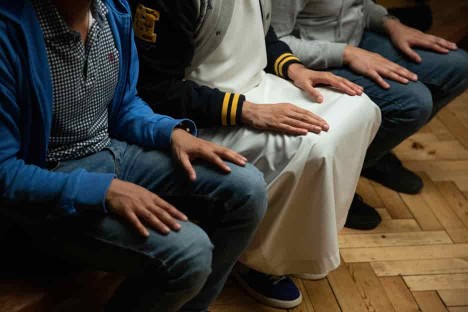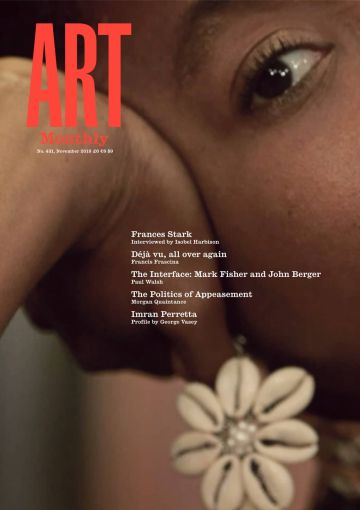Profile
Imran Perretta
George Vasey discusses the coercive role of images and hidden racial, social and economic biases of photographic and other technologies, as revealed in the work of the London-based artist.

Imran Perretta, the destructors, 2019
For much of the 20th century, Kodak’s colour film was made to photograph white bodies. In developing negative film, the company used chemicals that favoured lighter skin tones. The Shirley card, typically a photograph of a white female model, was sent to photography labs as an example of desired tonal ranges for skin. Photographic historians have often theorised the role of the photographer but rarely the ideological construction of the camera and its accompanying technologies. While the camera lens is directed by conscious and subconscious agendas, hardware and infrastructure is produced through a similar range of racial, economic and social biases.
The coercive role of images has accelerated as the technologies behind them have become smarter. From facial recognition to algorithms that predict behaviour, lenses – embedded in everything from smartphones to airport security systems and military drones – are constructed to make certain bodies more visible to authority than others. Imran Perretta’s films interrogate these visual regimes, exploring how power and surveillance are focused on black and brown people’s bodies. His films are, in part, a product of growing up in London as a teenager in the aftermath of the 9/11 attacks and being of Bangladeshi heritage. Coming of age in a world where he was keenly aware of the perceived threat of his own body, Perretta’s work describes state aggression enacted against young men of colour. This violence is manifested through the prism of the ‘war on terror’ and counter-terrorist strategies that naturalise a sense of omnipresent and unremitting threat.
Perretta’s brother to brother, 2017, recounts the artist’s experience of being stopped by an airport customs officer after travelling to the UK from Bangladesh. Its imagery is unfortunately familiar to many. We encounter Perretta’s naked body in a crouching position, perched on a stool. His head is covered with a black bag recalling the infamous torture photographs taken at Abu Ghraib by US soldiers. Perretta’s body is traversed by animated tracking points. The layering of corporeal and digital imagery articulates the ways in which the body is mapped and visualised by computational as much as human eyes. He sits against a green screen that, with its shallow depth of field, creates a purgatorial space magnifying a sense of claustrophobia. Images appear frequently, and often for short moments. Smoke, a frequent motif in Perretta’s films, seeps into the scene, suggesting the aftermath of an explosion. Water condenses and drips down the camera lens, evoking the use of waterboarding in interrogation. The film, like all Perretta’s work, is accompanied by a percussive soundtrack of incidental noises that creates a disorientating sonic landscape. Sound is expertly deployed in the films to suggest subjects just out of sight as well as calling attention to the machinery of the camera.
As dialogue appears on screen recounting the incident at the airport, Perretta’s body moves in and out of focus. The camera oscillates between static footage of the artist in the foreground and aerial drone footage which appears on the green screen in the background. These different forms of visuality – depicting figures horizontally and vertically – suggest different relations to power. In brother to brother, sight is removed from the powerless. To look without being seen is the privilege of authority. Perretta’s subjects are tracked and documented but cannot return the gaze that bears down on them; they are left unable to speak back to the authority that defines them.
DESH, 2016, opens with a poem describing a dream in which Perretta is being watched. We encounter the back of a walking figure, an armed guard. Digital tracking marks appear on screen and start to take on a life of their own. We cut to images of a nervous Perretta in a hotel room, his face framed out of shot. Blurred images of drones appear, and animated black smoke comes from the floor, which shift to blurred footage of children looking down at the camera. There is a general sense of unease in the film, the nondescript hotel room invaded by the militaristic imagery. From the intimate to the social, from the vertical and disembodied view to the closely cropped first-person vantage point, the body is put under a sense of continuous, heightened duress.
15 days, 2018, tells the story of the refugee ‘15 days’ whom Perretta befriended in a camp in Dunkirk. The enigmatic alter ego of the refugee comes from the fact that the French police last cleared his belongings 15 days before. The refugees in Dunkirk are mainly Iraqi Kurds, Afghans, Iranians and Syrians escaping persecution and war. The film captures the sense of temporal dislocation at the camp and the protagonist’s isolation, caught between international borders while living under a constant state of terror. The film splices footage shot by the artist at the camp alongside a digital 3D rendering of the protagonist’s makeshift quarters based on photographs. As 15 days delivers a monologue, his body remains absent. His tent slowly degrades. He recounts the ‘slow labour’ of waiting and feeling the ‘weight of white eyes bearing down on him’ as he is portrayed as being part of the ‘brown multitude’. This is a despairing account of a bleak situation. If the border is a site of privileged mobility, this film portrays a community whose immobility is horrifically apparent. Perretta foregrounds 15 days’s voice and story, while removing the visibility of his body. The film demands the right to invisibility and anonymity for its subject. As he remains stuck between borders with his human rights trashed, Perretta returns a certain dignity to the refugee.
Presently on show at Spike Island in Bristol, Perretta’s latest film, the destructors, 2019, focuses on a group of young South Asian men with Muslim backgrounds at a community centre in Tower Hamlets in east London. The work borrows its title from Graham Greene’s short story of the same title. Greene’s story is set in a postwar London still recovering from the Blitz and follows a gang of young people who aim to destroy an old man’s house. Perretta read the book as a teenager around the time of the 9/11 attacks and its description of criminalised young men resonated with how Peretta felt Muslim communities were being criminalised by the state and mainstream media in the popular imagination.
In the film we encounter four young people in an empty room with peeling paint. The remnants of workshops – notice boards and upturned institutional chairs – surround them. The building is in a state of disrepair from years of underfunding. The camera crops the protagonists’ bodies, retaining a sense of anonymity and, for a community so often characterised by the media on particular terms, this obfuscation grants them a certain agency. The two-screen film creates several simultaneous shots of the architecture and the men. The effect is intimate and forensic, analogising the building and the bodies. The personal testimonies are mapped onto the social. As the monologue is delivered, the building starts to encroach. Water floods into the corridors, as smoke seeps in the DESH video from the air vents. The delivery of the speech, which is slow and rhythmic, is accompanied by a minimal soundtrack of noises from the building which enhances the ominous tone.
The film starts with the men slowly clapping, creating the feeling of a funerary march. Read against the backdrop of an ailing community centre, the work symbolises the erosion of civic space. The public institution is in a state of ruination, with austerity enacting further violence against marginal communities. The welfare state becomes the ‘warfare state’, as articulated by one of the protagonists. It’s a place where ‘brown life can both cost too much and seem so very cheap’. In a shift from previous works, this piece has an elegiac quality: as communities become further atomised, Perretta’s films grant agency back to their subjects. They pinpoint the way in which certain bodies are made legible to authorities yet are rendered invisible as political subjects. Through a range of filmic strategies, Perretta gives a voice to their grievances. He looks up to the infrastructures of power, returning its gaze and making it visible so that he can return the privilege of sight to his marginalised subjects.
the destructors, Spike Island, Bristol, 28 September to 8 December 2019, Chisenhale, London, 17 January to 15 March 2020.
George Vasey is a curator at Wellcome Collection.
First published in Art Monthly 431: November 2019.










